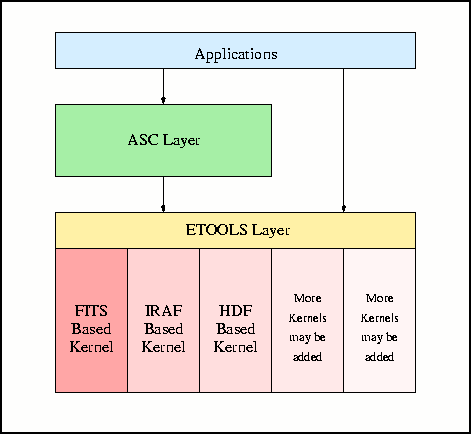
Figure: Layered Design of the ASC Data Model. Original PostScript figure (7kB).
Next: ASC Coordinate Transformation-The Pixlib Library
Previous: ASC Data Analysis Architecture
Up: AXAF
Table of Contents - Index - PS reprint
J. Herrero, O. Oberdorf, M. Conroy, J. McDowell
AXAF Science Center, Smithsonian Astrophysical Observatory,
60 Garden Street, MS 81, Cambridge, MA 02138
Previous requirements for the ASC data model stressed flexibility, extensibility, and economy (Conroy et al. 1995). These requirements can be further quantified so that an implementation design can be easily judged. What follows is a list of the quantified requirements that the implementation design had to meet:

Figure: Layered Design of the ASC Data Model. Original PostScript figure (7kB).
In order to to meet the requirement of support for multiple file formats through the same API, the library uses a layered approach. The bottom layer provides a standard API to multiple file formats. This API provides the other levels with a set of generic objects, such as tables and images, and will be implemented by adopting the ETOOLS package currently under development by a collaboration of CEA and SAO (Abbott et al. 1995; Abbott et al. 1997). The middle layer will add ``meaning'' to the ETOOLS data objects so that ASC applications can be designed easily and implemented in an consistent way. It will also provide scientific functions to manipulate the data. The top layer will consist of the actual ASC tools and applications. Please refer to Figure 1 to see a diagram of the different layers in our implementation design.
The ASC Data Library layer will provide the required AXAF science functionality to the generic data. It will be responsible for providing scientifically meaningful data objects, constructed from ETOOLS primary constructs, and data manipulation functions.
The Dataset Layer gives scientific meaning to the underlying generic objects. This layer will enhance or group the generic objects to produce specialized objects. For example, tools that need to operate on a ``Light Curve'' object would go through this interface to access their source or target objects. Here are two examples of new objects that the Dataset Layer would provide:
The Science Layer lies just above the Generic Layer. It contains routines to add additional meaning and functionality to the generic objects. For example, this layer will allow a column to have associated error values. Some examples of Science Layer functionality:
The decision to adopt the ETOOLS package as the generic layer of the implementation of the ASC data model was made because it meets the implementation requirements. The most important way in which ETOOLS meets these requirements is by providing a uniform interface through which different data file formats can be accessed. This is done by a kernel mechanism, in which there exists one kernel for each data file format desired (e.g., one kernel for FITS files, one kernel for IRAF files, etc.). The following list outlines all the ways in which the ETOOLS package meets the ASC data model implementation requirements:
The ASC will write at least two ETOOLS kernels to implement its Data Model, the first will be an IRAF based kernel and the second kernel will be a FITS based kernel. Other kernels could be implemented, like an HDF based kernel.
The ASC IRAF kernel will use IRAF files to store data on disk. One requirement for this kernel is that the object files (and especially the event tables) can be copied out of the ETOOLS environment, and still be valid IRAF files that can be analyzed in the IRAF environment.
This project is supported by NASA contract NAS8-39073 (ASC). We also gratefully acknowledge the many fruitful conversations with the other members of the ASC Data System and Science Data System.
Abbott, M., Kilsdonk, T., Olson, E., Christian, C., Conroy, M., Brissenden, R., & Herrero, J. 1997, this volume
Abbott, M., Kilsdonk, T., Olson, E., Christian, C., Conroy, M., Brissenden, R., Van Stone, D., & Herrero, J. 1996, in Astronomical Data Analysis Software and Systems V, ASP Conf. Ser., Vol. 101, eds. G. H. Jacoby and J. Barnes (San Francisco, ASP), 57
Conroy, M., Doe, S., & Herrero, J. 1996, in Astronomical Data Analysis Software and Systems V, ASP Conf. Ser., Vol. 101, eds. G. H. Jacoby and J. Barnes (San Francisco, ASP), 285
Van Stone, D., Conroy, M., & McDowell, J. 1996, in Astronomical Data Analysis Software and Systems V, ASP Conf. Ser., Vol. 101, eds. G. H. Jacoby and J. Barnes (San Francisco, ASP), 199
Next: ASC Coordinate Transformation-The Pixlib Library
Previous: ASC Data Analysis Architecture
Up: AXAF
Table of Contents - Index - PS reprint